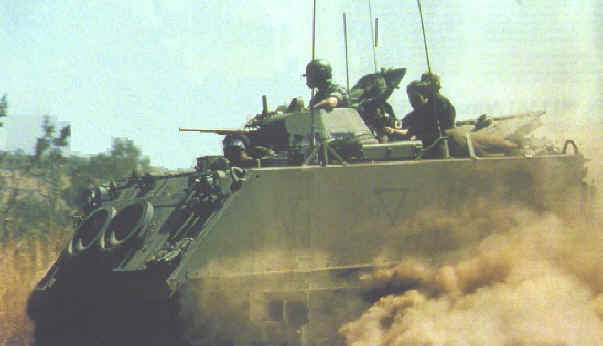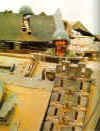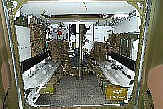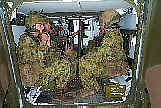 |
|
|||
|
|
||||
|
"a second class ride is better than a first class walk" |
| The quote above indicates the love/hate relationship that the infanteer has with the M113 Armoured Personnel Carriers (APCs) that are called "the tracks". This is a part of their story . . . |
|
|
| It was conceived in the mid 1950's. The APC went into Australian service in time for the Viet Nam war. It is still serving. It has a commander and a driver, a 50 calibre heavy machine gun (HMG) and space for 2 GPMG M6O machine guns. It is made out of aluminium, roars like a banshee, is as hot as hell inside for the 10 infantry diggers crowded into the back, makes you feel like a pea in a bottle being shaken and . . . . . it beats walking, sometimes. |
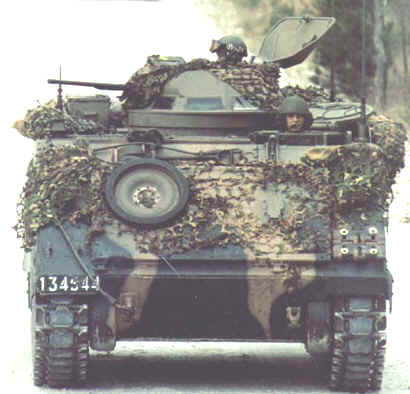 |
The army
currently has something like 760 of these machines in service. This one
was photographed with 2/14 QMI.
Starting with the original model the Aussies have added all sorts of bits and pieces, modifications and improvements to the tracks. (See below). They still do their main job well, and that is to move a section of infantry, quickly and relatively safely, up to the sharp end where the action is. |
|
Tracks in the outback. APCs are a go anywhere vehicle, but, like all vehicles they sometimes breakdown. When they do a vehicle recovery track comes along. >>> |
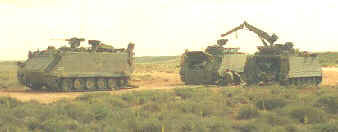 |
|
Let me set the scene; it is a stinking, non-descript rubber plantation in a place that no one was much interested in, the rain is pouring down as only Asian monsoonal rain can, 108 Australians are fighting for their lives against an estimated 2,000 to 2,500 NVA troops who are on their way to wipe out the whole Australian base at Nui Dat. It is Delta Company of 6 RAR and they are in "deep shit". They have already lost a section and more. Their ammo has run out once and only an emergency resupply from a RAAF chopper has allowed them to keep firing. Supporting artillery is firing 'continuous fire' (24 guns firing 3 rounds per gun per minute) and will drop a total of 2,639 rounds of 105mm and 155 rounds of 155mm (from the Yanks). There are already about 15% of the Australian unit KIA. More are wounded. Some are missing. All are desperate. The NVA/VC are massing for the last attack. The Australian Company Commander has already told his base "If you don't come for us in half an hour, don't bother coming at all'. Then through the murk, the rain and the bullets . . .a dull roar, like a couple of bulldozers, no one knew what it was. Then it struck them. The tracks had arrived. Out of the gloom, lights blazing, 50 cal machine guns going full bore, having already swum a flooded river, with another Company of 6RAR aboard the M113s of the RAAC came roaring in almost Western movie timing to break up the NVA/VC attack and relieve the situation. The NVA/VC withdrew leaving 245 bodies that they could not retrieve.
They call the place LONG TAN. |
| The Yanks call them the M113 ACAV which stands for Armoured Cavalry Assault Vehicle. We call them M113 APC for Armoured Personnel Carrier. The troops just call them....the tracks |
|
when it's time to go . . .GO |
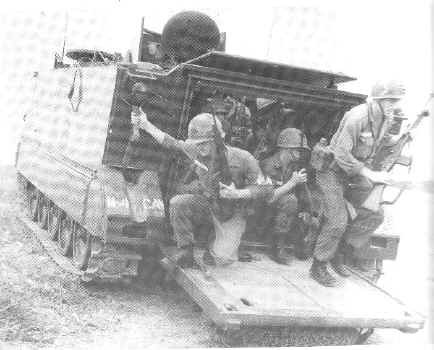
The M113A1 Light Recon. VehicleThe LRV was manufactured by General Motors starting around the sixties. The hull is made of aluminium and measures 4.86 metres long and 2.68 metres wide.. It is powered by a V6, two stroke, 210 brake horse power, 2800 RPM, Detroit diesel motor that is capable of moving the 10.9 tonne vehicle at speeds of up to 65 Kph. The vehicle runs on tracks (each weighing approx. one tonne) to allow it to cover a large variety of ground types and can tackle slopes of up to 60% and side slopes of 30%. The armourment consists of one 50 cal and one 30 cal machine gun that can be fired individually or together, mounted in the T50 turret which, not standard, was added to the vehicle by the Australian Army to afford the Crew Commander greater protection. The normal crew for a recon vehicle is two, the Crew Commander and a driver, however it is quite normal for an assault section to be attached to a troop and therefore require transportation in the rear of the vehicle bringing the total to twelve |
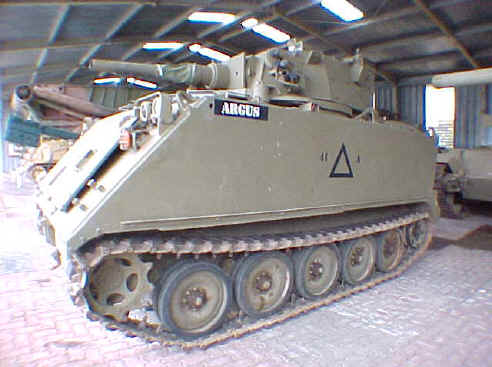 |
THE BEAST Australians love to improvise, alter, adapt and create. |
 |
It probably comes from a combination
of being under supplied with equipment because we are never ready for a
war and from the mend and make do attitude of the last bastion of the
Aussie bloke, his back-yard shed.
The Beast is a modified APC with a gun turret added. How and why it came into existence is a matter for debate. I have heard several stories. When I get the details near enough to true I will add them here. If you want to tell me YOUR version CLICK HERE |
 |
| Known as the "Green
dragon" to the VC in the early stages of the war. The M113 was
destined to become one of the most successful armoured vehicles of all
time. Seeing action in Vietnam on a wide scale from the DMZ to the
Delta.
In 1962 the first M113s arrived in Vietnam and were given to ARVN units. In March 1962 a consignment of 32 M113s that were on their way to Europe were diverted and also given to the ARVN. These first M113s were powered by a 209HP Chrysler 75M petrol engine. By 1964 the M113 had been superseded by the updated M113A1. The M113A1 was fitted with a General motor's 215HP Diesel engine which gave it an improved performance over the earlier M113. Crew:Each M113 had a crew of two, a commander and a driver, and could carry eleven men and their equipment. The driver sat on the L/H side of the vehicle, and had a good field of vision through four periscopes which were mounted in the cupola. The commander was situated centrally in the vehicle and had a fully rotating cupola with five periscopes. The commander also acted as the gunner and operated the .50 cal machine gun, this could be rotated through a full 360 degrees to give an all-round field of fire if needed. The ammo for the 50 was stored in portable boxes behind the infantrymen's seats. Originally the .50 cal gunners position was exposed and VERY unprotected. After the battle on Jan 2nd 1963 at Ap Bac, (in which fourteen ARVN M113 gunners had been killed) a combination shield and turret was designed which afforded much needed protection. This eventually was fitted as standard to all M113s. Armour, Wheels and Tracks:The cold rolled alloy hull of the M113 was made from Aluminium, Manganese and Magnesium. It's armour thickness varied from 3/4" to a maximum thickness of 1 1/4". This thickness provided protection from small arms fire and shell fragments, but would not stop a round from the soviet made RPG-7, or withstand the blast from a land mine. One of the best features of the M113 was it's ability to operate in an amphibious roll with out the need of specialist preparation. The hull of the M113 was constructed as a watertight unit, with all hatches and doors fitted with rubber seals to make them watertight. The front of the vehicle was fitted with a hinged breakwater plate which helped to stabilize the vehicle during operations through water. In the amphibious role the M113 was propelled by it's tracks, this was further enhanced by the rubber track shroud on each side of the hull, giving the M113 a top speed of 3 mph through water. The 63-64 link tracks were 15" wide and of a swivel link type, housed in rubber bushings to give them maximum elasticity. The tracks themselves ran on ten pairs ( 5 each side) of 24" Aluminium road wheels which were in turn each fitted with a solid rubber tyre 2 1/8" thick. The track life span on the M113 was supposed to be about 3,000 miles, but this was regularly exceeded, and has been known to go as high as 9,000 miles. ACAV:In 1965/66 some of the first M113s were converted into ACAVs (Armoured Cavalry Assault Vehicle) by fitting them with side mounted M60s and gun shields. Sandbags were placed on the floor of the inner troop compartment to absorb some of the blast from land mines. Sandbags were also placed on the outer hull and arranged as parapets around the troop compartment so as to allow the infantry to fire over the sides. As well as using sandbags for absorbing the blast from mines, ACAVs were also fitted with Titanium plates beneath the belly for the same reason. Other mods to change the M113 into ACAVs involved ripping out all but the drivers seat, to make more room for the carrying of essentials like loads of ammo. The ammo was stacked two layers deep, and wall-to-wall in the troop compartment. As well as as much ammo as they could carry the ACAVs space was also filled with the crew's kit bags, spare gun barrels, water, C-rations, crew weapons, grenades, tool box, and a set of towing cables. At a mere 22,000 Dollars per vehicle, the US Army had come up with a good all rounder. The M113 proved to be an excellent and effective Armoured Fighting Vehicle that went anywhere in Vietnam and did everything - and more besides! This section Copyright © 1996 Martin Tingey. Non-commercial distribution for educational purposes permitted if document is unaltered. Any commercial use, or storage in any commercial BBS is strictly prohibited without written consent. |
|
LAND 106 M113 Upgrade Project |
||
On
15 July 2002, the Minister for Defence announced that his department had
signed a $400m contract with Tenix Defence Land Division for the upgrade
of 350 M113 tracked armoured fighting vehicles.
The M113AS Family of Vehicles (FOV) will have greater firepower, protection and mobility than the existing M113A1 fleet.
Tenix has chosen German company FFG as the major technology partner for the program. Other key subcontractors and suppliers include Thales Optronics, Moog GmbH, SKF Australia, Bisalloy and a number of Australian SMEs.
|
||
